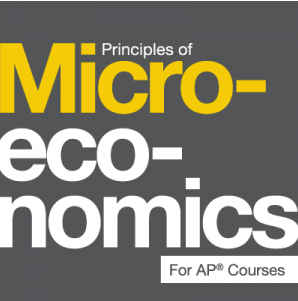
Principles of Microeconomics for AP®
The comprehensive contents from this book, combined with Odigia’s Teaching and Learning Tools have everything you need to engage, collaborate, track and assess your students.
This course includes:

341
practice questions

45
engagement activities

1341
assessment questions
Helping Teachers Do What They Do Best: Teach

Customize
Use our courses as is or easily customize them to fit your teaching style and the needs of your students. You can add your favorite resources, hide and show our existing content and pre-built assessments, or make them your own. Everything your students need, in one place!

Engage and Collaborate
Odigia combines learning materials, discussions, and tools to create a familiar social experience for students allowing you to easily connect and redirect students attention.

Track
See how much time students are spending on different areas of the course, which areas are creating the most amount of engagement and identify topics the students are struggling with. Flag and provide feedback on assignments to proactively meet individual students' needs.

Assess
Game theory allows students to monitor their progress visually and motivates them to stay on track. Students can see exactly what activities they need to complete, which ones have been flagged and compare their progress against the overall class.
Principles of Microeconomics for AP® Course Outline
What is economics?
- Why is economics important?
- What are the differences between microeconomics and macroeconomics?
- How can economists use theories and models to understand economic issues?
- How are economies organized?
How does scarcity affect economies?
- How should individuals make choices based on budget constraints?
- How does production possibilities frontier influence social choices?
- What are the major objections to economic approaches to decision making?
Why is the relationship between supply and demand important?
- How does demand and supply affect markets for goods and services?
- How does demand and supply shift for goods and services?
- How are changes in equilibrium price and quantity a four-step process?
- What are price ceilings and price floors?
- How does demand and supply relate to efficiency?
What factors affect the labor and financial markets?
- How does work in labor markets influence demand and supply?
- Who are the demanders and suppliers in a financial market?
- How does the market system serve as an efficient mechanism for information?
What is elasticity?
- How is the price elasticities of demand and supply calculated?
- What are polar cases of elasticity?
- How does elasticity affect pricing?
- What are other areas affected by elasticity?
How do consumers make choices?
- What are consumption choices?
- How can changes in income and prices affect consumption choices?
- What are labor-leisure choices?
- How do intertemporal affect financial capital markets?
How does cost affect industry structure?
- How does explicit and implicit costs affect accounting and economic profit?
- How is the structure of costs designed for the short run?
- How is the structure of costs designed for the long run?
What makes perfect competition?
- Why does perfect competition matters?
- How does perfectly competitive firms make output decisions?
- How are entry and exit decisions made for the long run?
- Why is efficiency important in perfectly competitive markets?
What is a monopoly?
- How are monopolies formed?
- How does a profit-maximizing monopoly choose outputs and prices?
What is the difference between monopolistic competition and oligopoly?
- What is monopolistic competition?
- What is oligopoly?
How does monopoly relate to the antitrust policy?
- What are corporate mergers?
- How is anticompetitive behavior regulated?
- How are natural monopolies regulated?
- What is the great deregulation experiment?
How does environmental protection relate to negative externalities?
- What are the economics of pollution?
- What is command-and-control regulation?
- What are examples of market-oriented environmental tools?
- What are the benefits and costs of U.S. environmental laws?
- What are examples of international environmental issues?
- What is the tradeoff between economic output and environmental protection?
What are the positive externalities in public goods?
- Why does the private sector under invests in innovation?
- How can governments encourage innovation?
- What are public goods?
What are the problems with poverty and economic inequality?
- Where is the poverty line drawn?
- What is the poverty trap?
- What is the safety net?
- What are the measurements and causes of income inequality?
- How do government policies help reduce income inequality?
Why are unions, discrimination, and immigration issues in the labor markets?
- What are unions?
- How does employment discrimination happen?
- Why does immigration matter?
How does information and risk relate to insurance?
- What is the problem with imperfect information and asymmetric information?
- Why does insurance have imperfect information?
What role does financial markets play in society?
- How do businesses raise financial capital?
- How do households supply financial capital?
- How is personal wealth accumulated?
What is public economy?
- How does voter participation affect costs of elections?
- What are special interest politics?
- What are flaws in the democratic system of government?
What is international trade?
- What is the difference between absolute and comparative advantage?
- What happens when a country has an absolute advantage in all goods?
- How does intra-industry trade happen between similar economies?
- What are the benefits of reducing barriers to international trade?
How does globalization relate to protectionism?
- How is protectionism an indirect subsidy for consumers and producers?
- How does international trade affect jobs, wages, and working conditions?
- What are supporting arguments for restricting imports?
- How is the trade policy enacted globally, regionally, and nationally?
- What are types of trade-offs of the trade policy?
Principles of Microeconomics for AP® Courses has been developed to meet the scope and sequence of most introductory microeconomics courses. At the same time, the book includes a number of innovative features designed to enhance student learning. Instructors can also customize the book, adapting it to the approach that works best in their classroom.
About the authors:
Senior Contributing Authors
Timothy Taylor, Macalester College
Contributing Authors
Cynthia Gamez, University of Texas at El Paso
Andres Jauregui, Columbus State University
Ralph Sonenshine, American University
Diane Keenan, Cerritos College
Dan MacDonald, California State University San Bernardino
Amyaz Moledina, The College of Wooster
David Shapiro, Pennsylvania State University
Craig Richardson, Winston-Salem State University


